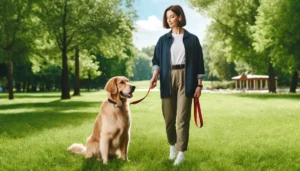Training your dog is an important part of being a good pet owner and will help you get along well with your furry friend. Basic training not only keeps your dog safe and healthy but also makes your daily interactions with him more enjoyable for both of you. This book will teach you basic dog training techniques so you can build a strong bond with your furry friend.
Table of Contents
Toggle1. Use Positive Reinforcement:
An important part of teaching your dog well is using positive reinforcement. This way you can thank your dog for something you want him to do, making him more likely to do it again. You can reward them with treats, compliments, or fun. When your dog does what you say or behaves well, immediately give him positive reinforcement to continue doing so.
For example, to teach your dog to sit, slowly guide him into the sitting position and then give him a treat while saying, “Good sit!” Because of this good association, the dog will be more likely to sit independently in the future.
2. Consistency is Key:
Consistency is very important when teaching a dog. Dogs like routine and clear instructions and expectations can help them know what you want from them. Use the same commands and gestures every time to make sure everyone in the house knows the rules and what is expected of them. This way you prevent your dog from getting lost.
For example, if you say “down” over and over again, your dog will lie down. Do not use other words such as “go down” or “lay down” as this may confuse your hat.
3. Short Description:
Teaching your dog simple commands is the first step in being able to talk to him. Start with simple words like ‘lie’, ‘stay’, ‘come’ and ‘sit’. These instructions are not only helpful but necessary to keep your dog safe.
- Sit: This command is useful in many situations, for example when you are on a leash or when friends come over. To get your dog to sit, hold the treat above your head and move it back and forth.
- Stay: For your safety, it is very important to teach your dog to stay. Start with small distances and slowly add more time to each distance. To thank them for their stay, give them a snack and praise them at the same time.
- Come on: having a good recall command is important, especially if your dog is off-leash. Speak in a pleasant voice and give them a treat when they come to you. In potentially dangerous situations, this command can save your life.
- Down: When teaching your dog to “sit,” use treats to help him get into a down position. Knowing this order is helpful if you want your dog to stay calm or want to make new friends.
4. Training Line:
For the dog’s safety and the owner’s peace of mind, leash training is a must. Start by handing the leash to your dog in a friendly and safe manner. Let them sniff the leash and look around before fastening it. Get them used to walking next to you without having to park for long periods.
Stop and wait for your dog to come back to you when he pulls on the leash. When they do this, reward them to reinforce the idea that not pulling is a good thing. Over time, positive feedback will help your dog associate walking on a loose leash with good feelings.
5. Making Friends:
Socialization is very important for a dog to behave well and feel confident. From a young age, take your dog to different places, meet new people, and play with other animals. This helps prevent problems with fear and violence from recurring. Schedule limited play dates with other dogs so your dog can experience new sounds, sights, and situations.
Reward your dog for being calm and friendly when he meets new people. If your dog shows signs of stress or anxiety, comfort him and introduce stimulation slowly and in a controlled manner.
6. Be Patient and Persistent:
Training a dog takes time and care. Keep in mind that dogs learn at their own pace and may not learn immediately. If your dog has trouble following directions, go back to basics and train him in smaller, easier steps.
To be successful, you need to practice regularly. Train your dog regularly for short periods, focusing on rewarding good behavior and teaching new commands slowly.
Conclusion
To ensure that you and your dog can develop a strong and positive bond, you need to know basic dog training techniques. Consistency, positive reinforcement, simple commands, self-control training, socialization, patience, and perseverance are all important components of effective training. Investing time and effort into teaching your dog can make the home a better place for you and your furry friend.
FAQs
1. When should I teach my dog new things?
Get your dog trained as soon as possible, preferably while he is still a baby. But if you’re patient and consistent, dogs of any age can learn new things.
2. Positive rewards are one way to train your dog. Why is it so important?
If your dog does something you want and you give him a treat, he’s more likely to do it again. It’s important to make training fun for both you and your dog so you can build a strong bond.
3. How long should exercise last?
Training sessions should last between 5 and 10 minutes for puppies and up to 15 minutes for adult dogs. Short meetings that are held frequently are more successful than long meetings that are held infrequently.
4. What should I do if my dog doesn’t listen to me?
If your dog doesn’t listen to you, you need to go back to basics and train him in smaller steps. Be patient, use positive feedback, and make sure what you say and what you expect are always the same.
5. What can I do to prevent my dog from pulling on the leash when we go for a walk?
When training your dog to walk on a leash, stop and wait every time he pulls on you. Rewarding them when they come back to you teaches them that walking without pulling is a good thing. Over time, positive feedback on the leash will make the dog behave better.
6. Is it important for all dogs to meet new people and new dogs?
Yes, socialization is important for all dogs. Being in different places, with different people and animals, can help prevent fear and violence. Start socializing your dog early and continue doing so for as long as he lives.


